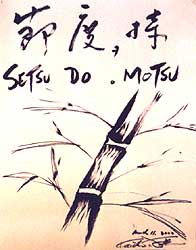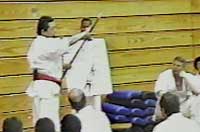Setsu Do Motsu:
A Lecture on Karate-do
By Kaicho Tadashi Nakamura, 9th Dan
Head of the World Seido Karate Organization
Editor's Note: Kaicho Nakamura still speaks with somewhat of
a Japanese accent. His use of words and sentence structure in this lecture
have been retained as much as possible to give a better sense of his person
and flavor of his speech.

I have a few things today that I would like to mention. Sometimes way
people starting karate, they are just only concerned with their technique,
how they kick or punch, or their forms. But more than that, the way you
study is not just your kata, your fighting form, or fighting spirit but
how you study karate applied to daily life. And we always say, the way
we study in not only karate, but karate-do. So lots of moral, lots of
discipline is required to call yourself karate-ka. So each of you here
I think -- continue good moral, good discipline --moment to moment.
(Kaicho Nakamura then points to a sketch of a bamboo stalk with the
words "Setsu do Motsu" written above it.) 
This is one of my favorite expressions. I want you to remember these
words today -- especially discipline and flexibility. Together they mean
Setsu do Motsu.
In training, certain times come when you must tighten yourself. (Here,
Kaicho Nakamura holds his hands in front of his body as if holding a sword.
He twists his hands inward as if tightening something.) Discipline.
This is Setsu do Motsu. You must always carry discipline.
(Then he points to the lowest segment of the bamboo stalk.) Certain
times come when you must tighten yourself. Then another time comes when
again you must tighten yourself (pointing to the bamboo segment above
the first one). This is the way we grow. Each segment is stiff, has
strength, discipline.
| Editor's note: Japanese characters are not lifeless, but
have distinct personalities whose sub-elements are often rich in
interpretation and subtle meaning. More |
(Kaicho Nakamura then picks up two practice sword. First he shows
a solid wood sword.)  What
I have here is a bokken, kind of hard. (Then taking the solid wooden
sword, he smacks it hard on the floor.) "WHACK." (He
then picks up a practice kendo sword made of strips of tied bamboo.)
This Shinai is made of bamboo and is hollow inside, but when it hits the
floor, "WHACK," it is flexible and doesn't break. Still it is
serious sword. When we fight against solid wood practice swords, sometimes
they break, but with a shinai we can hit hard and it doesn't break. So
I want you to understand bamboo -- it has flexibility. What
I have here is a bokken, kind of hard. (Then taking the solid wooden
sword, he smacks it hard on the floor.) "WHACK." (He
then picks up a practice kendo sword made of strips of tied bamboo.)
This Shinai is made of bamboo and is hollow inside, but when it hits the
floor, "WHACK," it is flexible and doesn't break. Still it is
serious sword. When we fight against solid wood practice swords, sometimes
they break, but with a shinai we can hit hard and it doesn't break. So
I want you to understand bamboo -- it has flexibility.
When growing bamboo must have this (he points to each distinct segment
of bamboo along its trunk) in order to grow. Without it (the segments)
it would fall down without strength.
In the winter time when I was a kid I used to go with my family to part
of Japan (northern island) where there was lots of snow, an area that
also had lots of bamboo. There was lots and lots of snow, and as the bamboo
became covered with snow, down, down, down it would bend almost to the
ground. (Nakamura here uses one of the wooden swords to illustrate
it bending over under the weight of the snow.) There were also some
sorts of trees and when lots of snow came, even big branches would break.
But bamboo in winter time and snow bends, goes down almost to the ground.
Then winter changes, snow starts to melt. A little bamboo comes up, comes
up and comes up (here still using a wooden sword, he holds it straight
up again) and 'aaahhh.' Then chance more to grow. This always remind
me of Setsu do Motsu.
Without discipline we can go down and stop (ending up there). So remember
as Karate-ka, always have flexibility, but also strength in discipline.
This is easy when in the dojo, when in front of the teachers or senpais,
easy when you have your belt on and can say 'I'm Karate-ka, I have good
form, I am fighting, I work hard.' But after you get changed, wherever
you go -- sometimes you forget. It's all attitude -- be careful. Wherever
you go you are karate-ka, you are your dojo. Carry on as if your dojo
exists wherever you go, especially when you are alone and no one watching.
You have to dedicate yourself. That is a very important thing. Easy when
people are watching, when you can say 'I'm a karate-ka, I'm a senior.'
But be careful. Wherever you go, when you are alone or in a different
place --STILL THE SAME WAY. Appreciate what you have. Appreciate what
you are. Then in Karate training watch yourself. UNDERSTAND? (Those
listening respond with a loud OSU.)
So please continue to be proud with what you are doing. Your karate is
not just karate discipline, skill, technique, your fighting or knowing
many kata. Most important IS TO BECOME A BETTER PERSON!
Even children should say, 'Since I started karate, I enjoy more my study,
listen more my parents and more concentrate. Since I study karate, I more
a chance to understand myself, more listen to other people and more appreciate
-- yourself and what you have. Then you become a good karate-ka.
Note: This lecture, was given in March 2000, to students
of Seido Karate at the Cornell College Champion Festival/ Tournament in
Ithaca, New York. Nakamura regularly lectures on aspects of karate-do
during weekly mediation sessions held at Seido Karate's New York City
Headquarters. A number of these lectures are published in his book, One
Day, One Lifetime -- An Illustrated Guide to the Spirit, Practice and
Philosophy of Seido Karate Meditation.
About The Lecturer:
Kaicho Tadashi Nakamura, 9th dan, is the founder (1976) and Chairman
of the World Seido Karate Organization ("Seido" meaning Sincere Way) and
established the Seido Juku headquarters in New York City. It has grown
into one of the largest and most respected dojos in the city and the Seido
system has spread accross the US and to more than 20 countires worldwide.
He is the author of many books on karate including "Karate, Technique
and Spirit", "The Human Face of Karate," and "One Day, One Lifetime,
An Illustrated Guide to the Spirit, Practice and Philosophy of Seido Karate
Meditation." Nakamura's karate is noted for its focus on teaching of the
mental and spiritual aspects of karate and for his belief that karate
should benefit everyone, not just the young and the strong.
|